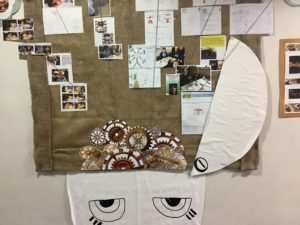DESIGN TECHNOLOGY

The school uses a variety of teaching and learning styles in design and technology lessons. The principal aim is to develop children’s knowledge, skills and understanding in design and technology. Teachers ensure that the children apply their knowledge and understanding when developing ideas, planning and making products, and then evaluating them. They promote an iterative process, allowing children to learn from mistakes and improve upon prototypes. We do this through a mixture of whole-class teaching and individual or group activities. Within lessons, we give children the opportunity both to work on their own and to collaborate with others, listening to other children’s ideas and treating these with respect. Children critically evaluate existing products, their own work and that of others. They have the opportunity to use a wide range of materials and resources, including ICT.
Intent
In the foundation stage (FS1&2) the children will continue to undertake rich cross curricular activities to assist in their progress working towards completion of their early learning goals. The children will also be assessed towards these learning goals.Although the children will not be expected to undertake Design andTechnology projects to the extent of KS1, they will be expected to complete extended design projects.
Each project will follow the design process of
- Research
- Design
- Make
- Evaluate
The topics covered throughout each year will be a balance of the main areas of Design and Technology including construction, textiles and a healthy food topic. The children will be encouraged to explore materials and tools throughout all of these projects.
Key Stage 1
Design – design purposeful, functional, appealing products for themselves and other users based on design criteria – generate, develop, model and communicate their ideas through talking, drawing, templates, mock-ups and, where appropriate, information and communication technology
Make -select from and use a range of tools and equipment to perform practical tasks [for example, cutting, shaping, joining and finishing] – select from and use a wide range of materials and components, including construction materials, textiles and ingredients, according to their characteristics
Evaluate -explore and evaluate a range of existing products – evaluate their ideas and products against design criteria
Technical knowledge -build structures, exploring how they can be made stronger, stiffer and more stable – explore and use mechanisms [for example, levers, sliders, wheels and axles], in their products.
As part of their work with food, pupils should be taught how to cook and apply the principles of nutrition and healthy eating. Instilling a love of cooking in pupils will also open a door to one of the great expressions of human creativity. Learning how to cook is a crucial life skill that enables pupils to feed themselves and others affordably and well, now and in later life.
- plan what to make and be able to tell someone else about it;
- make things from our plans and be able to say what has or has not worked well and why;
- work with tools and equipment safely to measure and mark, cut and shape, join and combine and decorate and finish different materials;
- learn about how to use different materials and mechanisms.
Through designing, developing, planning and communication their ideas the children will…
• Follow verbal instructions
• Explain what they are making and which materials they are using
• Name the tools they are using
• Describe what they need to do next
• Select materials from a limited range that will meet the design criteria
• Select and name the tools needed to work the materials
• Select appropriate technique explaining First……Next……Last….
• Explore ideas by rearranging materials
• Model ideas with kits, reclaimed materials
• Select pictures to help develop ideas
• Use pictures and words to convey what they want to design and make
• Describe their models and drawings of ideas and intentions
• Use kits/reclaimed materials to develop an idea
• Use drawings to record ideas as they are developed
• Discuss their work as it progresses
• Add notes to drawings to help explanations (begin to annotate)
Throughout all Design and Technology projects the children in Key Stage 1 will have the opportunity to develop their knowledge and understanding of basic sheet materials.
The children will…
• Fold, tear and cut paper and card
• Roll paper to create tubes
• Cut along lines, straight and curved
• Curl paper
• Insert paper fasteners for card linkages
• Create hinges
• Use simple pop ups
• Investigate strengthening sheet materials
Key Stage 2
Through a variety of creative and practical activities, pupils should be taught the knowledge, understanding and skills needed to engage in an iterative process of designing and making. They should work in a range of relevant contexts [for example, the home, school, leisure, culture, enterprise, industry and the wider environment]. When designing and making, pupils should be taught to:
Design
- use research and develop design criteria to inform the design of innovative, functional, appealing products that are fit for purpose, aimed at particular individuals or groups
- generate, develop, model and communicate their ideas through discussion, annotated sketches, cross-sectional and exploded diagrams, prototypes, pattern pieces and computer-aided design
Make
- select from and use a wider range of tools and equipment to perform practical tasks [for example, cutting, shaping, joining and finishing], accurately
- select from and use a wider range of materials and components, including construction materials, textiles and ingredients, according to their functional properties and aesthetic qualities
Evaluate
- investigate and analyse a range of existing products
- evaluate their ideas and products against their own design criteria and consider the views of others to improve their work
- understand how key events and individuals in design and technology have helped shape the world
Technical knowledge
- apply their understanding of how to strengthen, stiffen and reinforce more complex structures
- understand and use mechanical systems in their products [for example, gears, pulleys, cams, levers and linkages]
- understand and use electrical systems in their products [for example, series circuits incorporating switches, bulbs, buzzers and motors]
- apply their understanding of computing to program, monitor and control their products.
As part of their work with food, pupils should be taught how to cook and apply the principles of nutrition and healthy eating. Instilling a love of cooking in pupils will also open a door to one of the great expressions of human creativity. Learning how to cook is a crucial life skill that enables pupils to feed themselves and others affordably and well, now and in later life.
Cooking and Nutrition
- understand and apply the principles of a healthy and varied diet
- prepare and cook a variety of predominantly savoury dishes using a range of cooking techniques
- understand seasonality, and know where and how a variety of ingredients are grown, reared, caught and processed.
In Lower Key Stage 2 the children will…
- investigate and evaluate products to help generate ideas for our own work;
- make detailed plans for our ideas showing what we want to achieve and how to do it;
- use our plans to make products, evaluating and adapting our ideas as we work;
- work with tools and equipment safely and accurately to measure and mark, cut and shape, join and combine and decorate and finish different materials;
- learn about how different materials and mechanisms can be used for a purpose.
Through designing, developing, planning and communication their ideas the children will…
• Investigate similar products to the one to be made to give starting points for a design
• Draw/sketch products to help analyse and understand how products are made
• Think ahead about the order of their work and decide upon tools and materials
• Plan a sequence of actions to make a product
• Record the plan by drawing (labelled or annotated sketches) or writing
• Develop more than one design or adaptation of an initial design
• Propose realistic suggestions as to how they can achieve their design ideas
• Add notes and annotations to drawings to help explanations
Throughout all Design and Technology projects the children in Lower Key Stage 2 will have the opportunity to develop their knowledge and understanding of basic sheet materials.
The children will…
• Cut slots
• Cut internal shapes
• Make levers and linkages
• Use linkages to make movement larger or more varied.
• Use and explore complex pop ups
• Create nets
In Upper Key Stage 2 the children will
investigate and evaluate products to help generate ideas for our own work;
make detailed plans for our ideas showing what we want to achieve and how to do it; use our plans to make products, evaluating and adapting our ideas as we work;
work with tools and equipment safely and accurately to measure and mark, cut and shape, join and combine and decorate and finish different materials;
learn about how different materials and mechanisms can be used for a purpose.
Through designing, developing, planning and communication their ideas the children will…
• Investigate products/images to collect ideas
• Sketch and model alternative ideas • Develop one idea in depth
• Combine modelling and drawing to refine ideas
• Plan the sequence of work
• Record ideas using well annotated diagrams
• Use models, kits and drawings to help formulate design ideas
• Make prototypes
• Use found information to inform decisions
• Use a computer to model ideas
• Draw plans which can be read/followed by someone else
• Give a report using correct technical vocabulary
Throughout all Design and Technology projects the children in Upper Key Stage 2 will have the opportunity to develop their knowledge and understanding of basic sheet materials.
The children will…
• Cut slots
• Cut accurately and safely to a marked line
• Join and combine materials with temporary, fixed or moving joints
• Use craft knife, cutting mat and safety ruler under one to one supervision
• Choose an appropriate sheet material for the purpose


